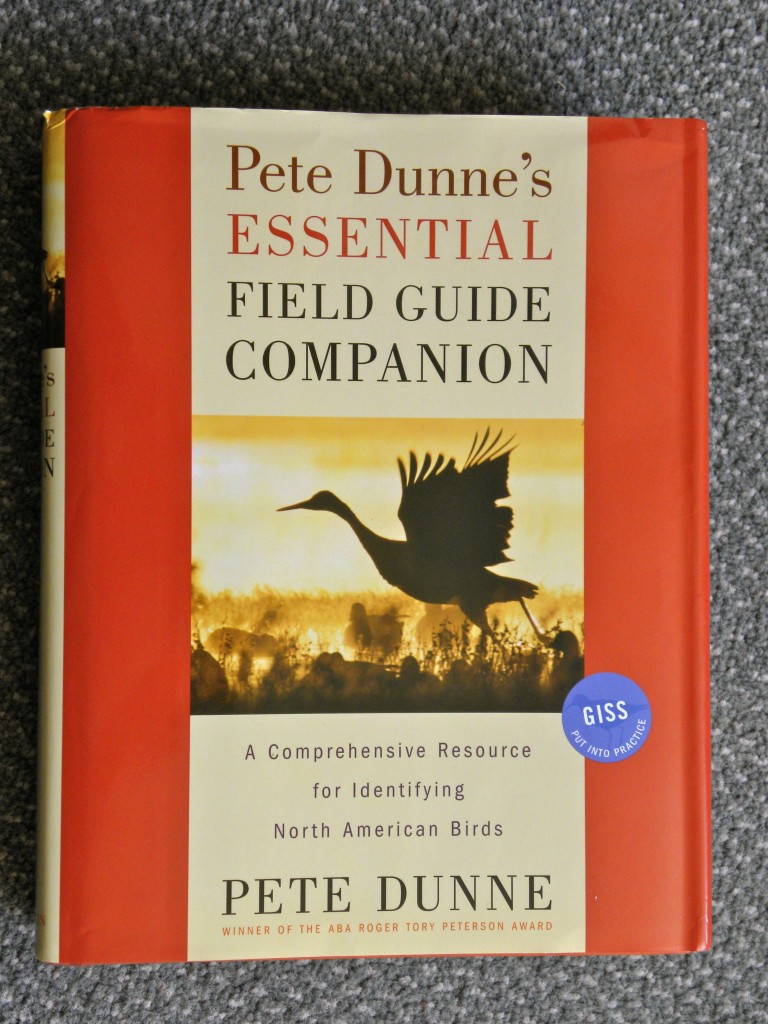In a few posts I have referred to Pete Dunne’s Essential Field Guide Companion. It’s a 680 pages hardcover without a single picture but with more concise bird species information than you’re likely to see anywhere else anytime soon. Get it. Published in 2006, it seems to be out of print, but I know it can be bought new or lightly used through ABE Books for around $30- $40. It is also available as a downloadable book through Apple’s iBooks app. 
I happened upon Pete’s book at my local library and knew after reading a very few pages that I had to have my own copy. Pete truly and effectively supplements the contents of any North American field guide. Field guides provide undeniably valuable field information. Sibley Guides or National Geographic, it doesn’t matter, you get the bird’s name, excellent colour illustrations that show all the key field marks, a range map or two and a few lines about song or characteristic behaviour. To be fair, they usually devote paragraphs summarizing general characteristics of family groups or distinguishing differences between similar species. But that’s pretty much where it stops.
Pete Dunne has taken the next logical step and added everything that’s left unsaid by a compact field guide . There are no illustrations in Pete’s book, but the text is lively, amazingly descriptive and often funny.
All of his species accounts have a consistent format; for the sake of illustration I am referring at his Gray Jay page. It provides the Name (of course) and a nickname – Spruce Ghost in this case. Then comes technical stuff like Status in which he outlines in broad terms the species’ geographical abundance: common, widespread, highly-localized, etc. A discussion of Distribution is quite detailed and rather than the lengthy listing of states and provinces could perhaps have been better illustrated with range maps . Habitat provides useful detail about the species’ preferred topography and associated flora. And a really useful section on Cohabitants provides the sort of information that makes you think: “Yes of course!”. In the case of the Gray Jay its cohabitants are listed as Spruce Grouse, Northern Hawk Owl, and Boreal Chickadee. A Vagrancy Index note rates the species’ tendency, on a scale of 1 to 4, to wander. He rates the Gray Jay as a one, Black-throated Gray Warbler a three and European Starling a four.
Next the chatty part. In Description he describes and talks about the bird’s plumage and overall appearance, how it looks and what it looks somewhat like (which is really useful), where it sits size-wise in comparison to likely companion species, how it perches; all the subtle stuff that go to make up the GISS (General impression of size and shape). In Behaviour he describes the bird’s conduct, the Gray Jay is described as “Ghostlike in its ability to appear suddenly and silently on the limb just above your head…..drawn to human presence – gunshot, the opening of a cooler, a crackling campfire”.
Flight looks at mannerisms and style and includes helpful comments like this: “…spooky in its silence, its floating, time-suspended buoyancy and in the bird’s ability to glide through branches with smoke-like ease” Finally, some but not all species, get a Pertinent Particulars footnote in which Pete shares other stuff you’ll certainly be richer (or even safer) for knowing. In the case of the Gray Jay he writes: “ Gray Jays occur in the same range and habitat as Grizzly Bears and Black Bears, which also respond to pishing in general and squealing in particular. You might want to consider this before trying to imitate a wounded bird or animal in vegetation so dense that it prevents you from seeing what might be approaching (or is already there).”
You should by now have some idea of what a valuable back up piece of work this is. Countless times I have returned from a field trip with my mind still savouring a species or two. By reading Pete’s book I’ve always added to the experience and enriched the day.
Thanks for showing us the ruddy duck yesterday, our bird of the day today had to be a great blue heron on the niagara river by fort erie. We also saw a couple northern shovellers and some tundra swans on our drive!
I love visiting your site. Thanks for sharing your photos and your knowledge. I appreciate your book recommendation and wanted to let you know I was able to get two new copies of the book (one for myself and one for my brother) through Amazon.ca (http://www.amazon.ca/Dunnes-Essential-Field-Guide-Companion/dp/0618236481/). Price: CDN$ 25.04 & FREE Shipping. I thought that was a pretty good deal.
Good morning
I have been following and enjoying your posts since moving adjacent to South Shell “Birding Park” 2 years ago.
With regard to Pete Dunne’s Essential Field Guide Companion, I floated it and 10 other Peter Dunn publications on Apple’s iBooks app. The ebook editions run from around $10 to $20.
I’ve downloaded the Guide you recommended and look forward to enjoying it and hopefully, learning along the way.
Thank you.
Purchased the Dunne book on your recommendation… well worth it! He certainly adds whimsical colour and breathes life into standard field guide descriptions.
Thx again,
Angelique
Hi Peter:
Just to let you know that I hiked Bayfront Park in Hamilton this am and one of the swans has had 7 large eggs and she has built her nest at the Pavilion there just at the start of the walking path. Beautiful to see.